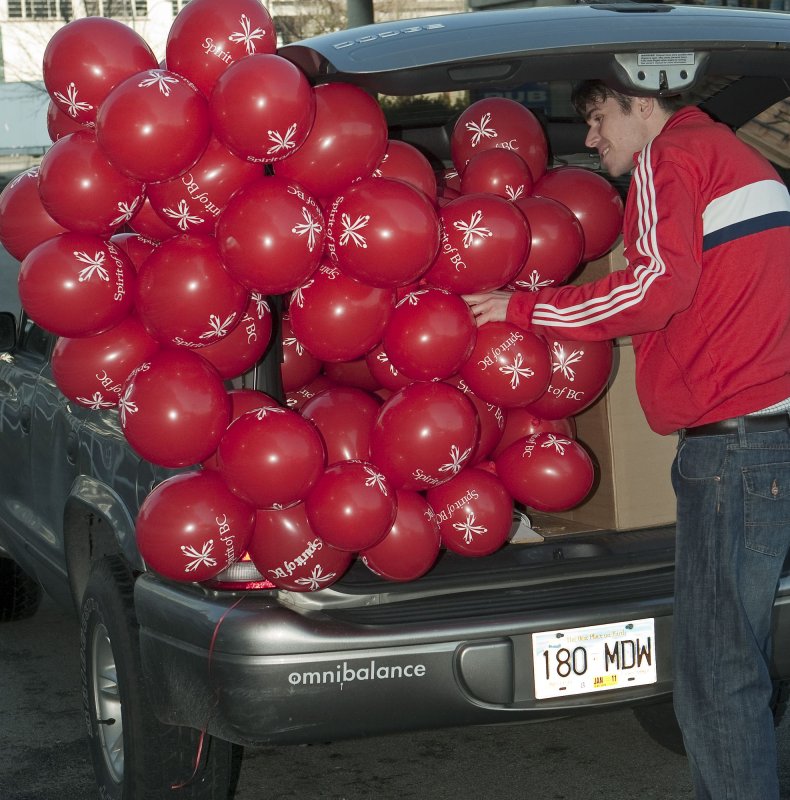1 of 2 | A volunteer has trouble stuffing decorative "Spirit of BC" balloons in a small hatchback on Day 103 of the Vancouver 2010 Winter Olympic Torch Relay near Vancouver, British Columbia (BC), February 9, 2010. UPI /Heinz Ruckemann |
License Photo
Recently the wife and I were talking about replacing one of our 1999 cars -- she drives a Toyota Corolla and me a Mercury Grand Marquis.
The Corolla has 80,000 miles and runs like it will go another 80,000 miles despite being rear-ended a few months ago. The only knock on the big black Merc is the 16/23 mpg the V-8 engine gets. With regular gasoline still around $4 a gallon it costs more than $75 to fill the dinosaur's tank.
So when I broached the subject of a new car I was shocked when she asked, "Are you going to get another hatchback?"
"A hatchback?!!!" We haven't had a hatchback since the early years of our marriage when the little Japanese four-cylinder with the big hatch earned its keep carting groceries, luggage, dogs, cats, furniture, camping equipment, gardening supplies and even a hot water heater.
We watched the Bulls last NBA championship run on a pre-flat screen 32" television we brought home during the playoffs inside the hatch -- sans the box.
To my surprise practical four-cylinder engine cars with a hinged rear door instead of a trunk are back.
"Between the fuel economy, the technology we're putting in the vehicles and the flexibility a five-door offers, we're seeing a lot more interest in our products," Robert Parker, group marketing manager at Ford Motor Co., told The Detroit News. Soaring gas prices have spurred sales of small vehicles and utility has also become a selling point.
About half of the new Ford Fiestas and more than 40 percent of new 2012 Ford Focus models are hatchbacks.
Hatchback sales jumped 63 percent from 2006 to 2010 -- from 291,853 to 475,048 -- at a time when overall passenger car sales fell about 23 percent, WardsAuto.com data indicate.
"The hatch was the vehicle for college kids with no money; and they were usually ugly," AutoPacific Inc. analyst Dave Sullivan told the News. He said the image of a U.S.-made hatchback as cheap, tiny and boring has changed and new models of the venerable five-door have "European flair and a lot of utility and good gas mileage."
For many, the crossover vehicle, those lower to the ground SUV wannabes on a car chassis, are the new hatchbacks, and most of them are not cheap.
-0-
South Korean automaker Hyundai expects 40 percent of sales of its updated Accent subcompact will be hatchbacks.
Hyundai President and CEO John Krafcik told the Detroit Free Press every version of the Accent will get 40 mpg on the highway. New Hyundais sold in the United States in June averaged 35.7 mpg.
A sporty passenger coupe called the Veloster will be launched with the same 1.6-liter, four-cylinder engine as the Accent this fall.
Hyundai hopes it has found the formula to sell more than 600,000 cars in the United States this year, which would be a 45 percent sales boost from 2010 at a time when vehicle sales are slowing.
"We're not in the camp that expects a miraculous recovery," Krafcik said. "Employment is not hitting the levels it needs to be at all."
After all the optimism of a renaissance for the U.S. auto industry, sales of new vehicles have moved into the slow lane.
Sales are better than during the troubled 2008-09 model years when General Motors and Chrysler declared bankruptcy and were bailed out by the federal government. Sales last month were 7 percent higher than June 2010, but down from May, Autodata Corp. said.
Would-be summer buyers face a double dilemma of higher prices and fewer choices as automakers dump incentives amid reduced inventory.
Japanese vehicle production stalled as a result of the March 11 earthquake and tsunami, cutting parts supplies and electricity needed to run factories. At the same time, vehicle production proceeded at a record pace in Mexico, which cranked out 1.23 million light vehicles in the first half of 2011.
The Wall Street Journal said car sales were hot in Latin America, and overall U.S. sales were expected to finish the year higher than last year sales would be lower than in pre-recession 2008.
The improvement in year-over-year sales is good news for what used to be Detroit's Big Three. Ford, GM and Chrysler combined to sell more than half of the light vehicles purchased in the United States in June -- with Chrysler sales up 30.2 percent, Ford up 13.3 percent and GM up 10.6 percent.
Toyota and Honda had their worst June sales in the United States in 14 years. Toyota's U.S. market share from January-June fell from 15.1 percent to 12.8 percent from the same period a year earlier. Honda's dropped to 9.6 percent, down 1 percent. Meanwhile, U.S. nameplates increased market share 1.2 percent in the first half of 2011 to 46.8 percent.
Automakers were on pace to sell 11.5 million vehicles in the United States -- better than the 10 million to 11 million in 2009-10 -- but well below earlier forecasts.
"The Japanese automakers really got hit hard, much harder than any one of us anticipated," TrueCar.com analyst Jesse Toprak told the Detroit Free Press.
Consumer publications and Web sites suggest this may be good time for consumers to do their homework: research and wait for more end of the year inventory to show up in auto showrooms this fall.
"We will see deals because the automakers will want to let buyers know the industry is competitive again," J.D. Power & Associates analyst Jeff Schuster tells the Free Press.
Who knows, gas prices may even moderate a bit.










